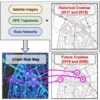Japanese telco giant NTT Docomo has developed a new proof of concept that it touts can “efficiently guide” 28GHz 5G radio signals received from outdoors to specific locations indoors.
Developed alongside AGC, a Japanese glass manufacturer, the new technology is a film-like metasurface lens that can be attached to window surfaces. Once attached to window surfaces, 28GHz radio signals are then able to pass through windows and become available for use indoors.
Generally, 28GHz signals have low diffraction, which means these types of signals are unable to penetrate windows and need to be within the line of sight of base stations, the company explained.
But the metasurface lens is able to circumvent this, Docomo said, as it arranges a large number of sub-wavelength unit cells into certain shapes, which allows direct radio signals to pass through to specific points indoors.
In addition, the metasurface lens material is a transparent film that can cover virtually the entire inside surface of a window and was designed to be “aesthetically acceptable”.
It also has no effect on LTE and sub-6 band radio waves, so it can be used to improve indoor reception of 28GHz radio signals without affecting the performance of legacy wireless frequencies, Docomo added.
Meanwhile, Ericsson has launched a 5G network slicing product for radio access networks (RAN) that allows for communications service providers to deliver customised 5G services.
The new 5G RAN slicing product allocates radio resources at 1-millisecond scheduling and supports multi-dimensional service differentiation handling across slices.
According to Ericsson, the 1-millisecond scheduling strengthens end-to-end slicing capabilities for resource management to make it easier for communications service providers to support customers across various use cases.
“What makes our solution distinct is that it boosts end-to-end management and orchestration support for fast and efficient service delivery. This gives service providers the differentiation and guaranteed performance needed to monetise 5G investments with diverse use cases. With 5G as innovation platform, we continue to drive value for our customers,” Ericsson Product Area Networks head Per Narvinger said.
Related Coverage
Docomo switches on sub-6GHz 5G carrier aggregation
Qualcomm says devices will need a Snapdragon 865 to make use of the feature.
NTT Docomo to launch 5G on March 25
Initial footprint to be 150 locations across Japan, followed by 500 cities in a year’s time.
Ericsson accuses Samsung of swerving FRAND commitments for 2G-5G patents
The delay in contractual negotiations could set Ericsson back SEK 1.5 billion per quarter from 2021 onwards.
5G rollouts gather pace, despite obstacles and arguments over coverage
O2, BT and rivals are in a race to deploy 5G to as many locations as possible, despite various obstacles to the technology’s rollout.



